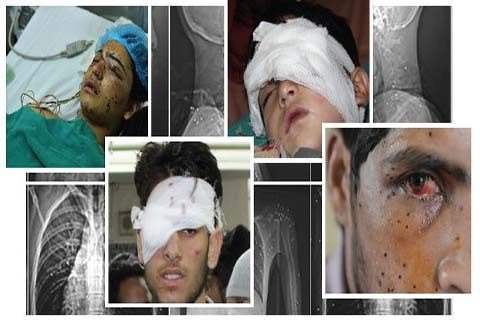Pellet Guns In Kashmir: Cases Of Injuries To Youths Continue To Be Reported, But Authorities Say Use Of Weapon On The Decline
Srinagar: Last week, after a gunbattle that lasted for nearly five hours, a group of militants managed to escape from a security cordon at Yarwan in south Kashmir’s Shopian. As the gunbattle ended around dusk, several civilians were left injured due to being sprayed with pellets.
In the first few hours, when the cordon was laid deep in the woods, there were no skirmishes between the forces and the youth. People were squatting on shop fronts at many villages along the Pulwama-Shopian road. But as the militants escaped, villages near the cordon site resonated with the sound of tear smoke shells.
On a cratered road that is only a few metres away from the last ring of the cordon laid by the forces, dozens of youth received pellet wounds. Though authorities had announced that pellet guns would be banned, security forces still use them. However, officials said, their intensity has declined.
In the gunfight at Yarwan, some security personnel also wielded long-barrel pellet shotguns. “I was just standing on the road when the forces fired pellets,” said a teenager, Showkat Ahmad Dar, who received pellet injuries to his torso.
Thirty-year-old Gulzar Ahmad Dar had also received pellets all over his body at Kralachak including the face and red spots had left him scarred. “The forces also fired the pellets into the houses,” he said.
Pellet shotguns were termed as “inaccurate” by human rights groups after hundreds were injured due to their massive use during the civilian uprising after the killing of Hizbul Mujahideen militant commander Burhan Muzaffar Wani in 2016. Hundreds were blinded, prompting human rights groups to seek a ban on the use of pellet guns.
International human rights group Amnesty International has described the use of pellet guns as “inherently inaccurate,” stating in a report that the weapon that was meant to be deployed for “crowd control” has been responsible for “blinding, killing and traumatising” people in Kashmir. “The effects of these weapons will be felt for years to come. Amnesty International India has documented the cases of 88 people whose eyesight was damaged — some temporarily, some permanently – by metal pellets between 2014 and 2017. Their lives have changed entirely, and they are struggling to cope,” the report said.
After the outcry over the use of pellets, home minister Rajnath Singh in 2016 said that the government was looking at introducing “non-lethal” alternative weapons to control mobs that rush to gunbattle sites to help militants escape from encounters. On 12 July, 2018, while replying to a question in Parliament about the casualties caused by pellet guns, Singh said that an expert committee will be set up to look at the non-lethal alternatives.
Top police officials have said that the use of pellet guns has decreased as the intensity of protests has also declined in southern Kashmir. Senior Superintendent of Police, Kulgam, Gurinder Pal Singh, said that after the decline in the protests, the use of pellet guns has reduced.
He said that unlike the situation in 2016, when thousands of protesters had hit the roads, the demonstrations have now been restricted to gunbattles only. He noted, “There is no comparison between the situation at present and that of 2016. At that time, crowds of thousands of people would gather every second day. Now, that happens only during an encounter. We have also taken safety measures like the use of deflectors on pellet guns. We have been issued new tear smoke shells, which have increased our effectiveness. Due to this, we use pellet guns less often. Also, security personnel are given more training on using such guns.”
However, Mohammed Ashraf Bhat, president of Pellet Victims’ Welfare Trust, said that the authorities have not followed through with their promise to ban pellet guns in Kashmir. He said that last year, around 230 youth either sustained injured or lost vision after they were fired upon with pellets. “In the protests that erupted after the killing of militant commander Zakir Musa, many youth were injured after they were hit with pellets,” he said, adding that the use of the weapon is more common in southern Kashmir.
Among recent cases, a youth was blinded in Shopian after he was hit by pellets, added Bhat.
(FirstPost)




